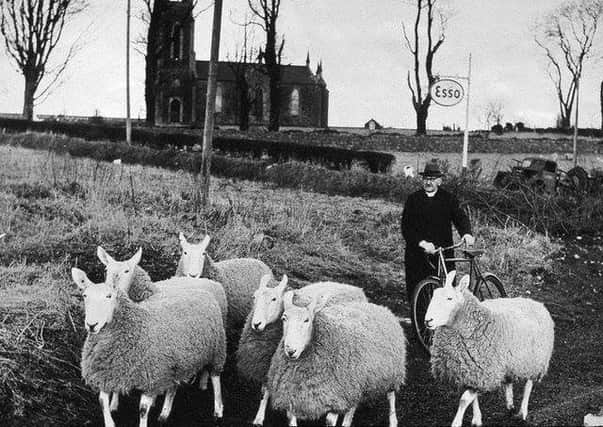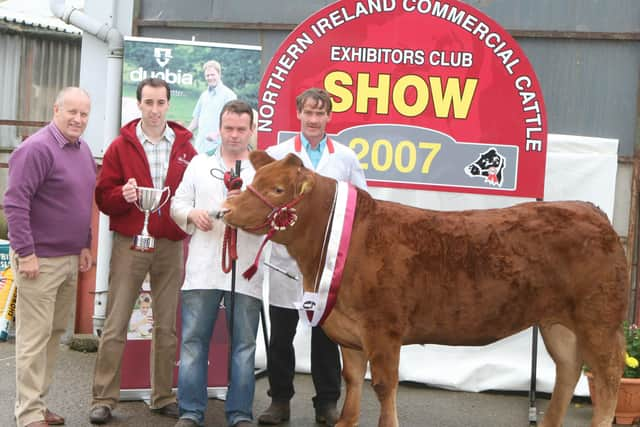BYGONE DAYS: Hay and straw is left ‘hopelessly ruined’ after farmyard blaze


The blaze involved the loss of hundred of tons of hay and straw, a large quantity of other farm produce and the destruction of an extensive corrugated iron shed at the farmyard of Mr J Hatrick.
The brigade in the city had received the call shortly after four o’clock and Superintendent Trimble with engine and a section of men, were quickly dispatched to the scene of the fire.
Advertisement
Hide AdAdvertisement
Hide AdWhen they arrived they found the large corrugated iron building, which was used as a storage for hay straw, turnips, etc, burning from end to end, and the building partly collapsed.


The Derry Journal noted: “So great, indeed, was the conflagration that it could be seen for miles around”
Owing to the proximity of the other buildings, including Mr Hatrick’s residence, there was a great danger of the fire spreading to these, and involving the whole farm buildings.
Fortunately Mr Hatrick had a supply of water at the farm, and this the brigade used until it became exhausted, after about an hour’s operations.
Advertisement
Hide AdAdvertisement
Hide AdThen the brigade were faced with the problem of getting more water.


The hay and straw was still blazing fiercely, and, although a portion of the corrugated iron roof had fallen on quantities of these, they continued burning below.
Moreover the wind changed, and threatened to blow the flames right on the other buildings.
Indeed, some of the wood work caught fire, and the brigade had to turn a jet on to it and to the inflammable roofs of the outhouses in order keep them cool.
Advertisement
Hide AdAdvertisement
Hide AdWith the farm water supply down Mr Trimble got the engine down to the straining well of the Creggan Reservoir, and with some difficulty the brigade got it into position and started pumping operations there, laying a hose across the hilly fields to the scene of blaze.
The engine continued work until the early hours of the morning, and the ruined shed and hay and straw were still smouldering until well into the day.
Mr Trimble advised Mr Hatrick that the only safe course was to remove the contents of the shed, to open up the hay and straw, and after spreading them in the fields pour water on them, otherwise they too would smoulder for days. This was done in the course of the evening.
The Derry Journal remarked: “Had it not been for brigade the entire range of farm buildings would have been completely destroyed. As it was, the outbreak was confined to the shed, which had been left “a mass of twisted iron” and the whole contents “hopelessly ruined”.
Advertisement
Hide AdAdvertisement
Hide AdMeanwhile dissatisfaction was expressed at the manner in which bulls were inspected for premiums at a meeting of the Tyrone Committee of Agriculture which was held this week in April 1928 held at Omagh.
The matter arose out of a resolution which was received from the Newtownstewart Milk Recording Association stating that, in their opinion, the court of appeal should be available to deal with premium bull awards or failing that the committee be composed of representatives from the province, with each committee agriculture to nominate a representative, and that these men be given power to select a man to act in conjunction with the ministry’s inspector in awarding premiums.
Mr Thomas Hagan said that in the Cookstown area 117 bulls had been put forward for licences and only three had been rejected but that when the same bulls were put up for auction 35 of them did not receive a single bid.
Mr Getty, the ministry’s inspector, said the ministry had decided to tighten the standard. He said that there had been very few complaints received by the ministry in regard to their inspectors and he questioned whether a man selected by the committee would get through the work “more expeditiously or keep a more uniform standard”.
Advertisement
Hide AdAdvertisement
Hide AdMr Rowley Elliott, MP, voiced a complaint that bulls were being purchased by the ministry outside Northern Ireland.
Mr Getty said a large number of men wanted black bulls.
He said: “As there is no possibility of getting sufficient black bulls in Ireland to meet the demand we had to go outside the country for them.”
Mr Getty added that he would give an assurance, however, that the ministry would whenever possible purchase premium bulls inside the northern area.
The resolution was left over for further consideration until the October meeting when the question of premiums would come up for discussion.
Fermanagh farmers alarmed at ongoing ‘caterpillar plague’
Advertisement
Hide AdAdvertisement
Hide AdFarmers in the district of Lisbellaw in Co Fermanagh had been “greatly perturbed” by the appearance of tens of thousands of caterpillars in grass lands on farms between that village and Maguiresbridge, and about a mile distance from this former, it was reported this week in 1928.
A local newspaper observed: “During the past few days the number of these strange little visitors has increased enormously, and if they continue to multiply at the present rapid rate, they threaten to become a serious plague in the district.”
At the request of the inhabitants the place had been visited by Mr T D Ritchie, agricultural inspector for Co Fermanagh, who was trying out a number of sprays, such as sulphates of copper, for killing off the insects or at least slowing down their increase.
Interviewed by a local newspaper representative, Mr Ritchie said the caterpillars were slightly smaller than mostly found in that part of Ireland, and were of a species unknown to him.
Advertisement
Hide AdAdvertisement
Hide AdThe newspaper noted: “During a spell of sunshine they swarm over grass land, the soil of which in some places seems to be literally alive with them, and local farmers are alarmed at the prospect of them invading their houses.
“They appear to feed on coarse grass, and their origin and character are so far unknown. The result of the efforts now being made to exterminate them is being followed with deep interest and anxiety by the local people in the affected districts.”
It was noted that a number of the caterpillars had been sent to the Ministry of Agriculture in Belfast for examination and identification by experts.